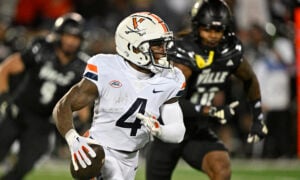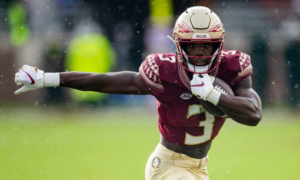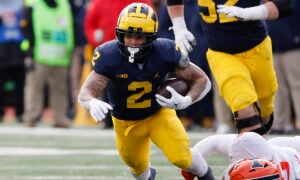Target Share Report: Week Nine
Welcome back to the target share report where we look at the usage from the previous week to try and understand which players are doing well and who is struggling. I keep playing with that opening line but it never feels right. Essentially the goal is to see things coming, as early as possible in dynasty, week to week, but also season to season for rookies or potential later breakout players. We’re looking for information to help us do that.
I’m running a little behind this week because of some real-life stuff. Apologies if this comes out late because of it. However, as always, I update my 2020 data every week on Monday (and again on Tuesday) after the week’s games have played.
You can also join live on stream every week while I collect and discuss first impressions of each week’s stats live on stream on Twitch, periscope and YouTube.
I know there’s always a lot going on in my tables. I’d love to roll it all up into one number and use graphs to pretend I’ve created a special, super-duper, stat to tell you everything. But, it’d be a lie. If you want to look at one number? Try Expected Points Per Game (EPG) but the others provide more context and information.
I’ll include information about the main stats I utilize at the end of the article again if you’d like to know more about any of them.
Enough preamble, let’s get nerdy up in here.
Top 12 in target share 2020
As always, let’s just take a glance at the leaders this year in target share.

Nice to see those 30% target shares have regressed back to “normal” already from last week. Anyway, I feel like I’ve written about all of these guys a lot this year, so just a few notes from the top “dawgs” this week.
Robby Anderson, WR NYJ
No, is apparently the answer to my seven-week long question “can Robby Anderson catch touchdowns?” It’s impossible, no amount of stats can stop it.
I’m tilting.
Tyler Lockett, WR SEA
I had some questions about Lockett’s target share this week on our weekly stream so I thought I’d address it here as well. I think collecting weekly stats or looking at them is a helpful excursive for anyone looking to understand the changing nature of player production. Some of it’s is hard to explain on a broad view, season-long like, perspective or take. But this isn’t one of them.
Target share is just not as consistent as you may think, and “consistency” as we sometimes think of it, doesn’t exist. Using the coefficient of variation (“CV”), a calculation that measures the variation in a sample of numbers, I looked at how wildly target share changes on a week-to-week basis for wide receivers.
In 2020, the average CV is around 33% of the top 12 players. For more context, Stefon Diggs, Keenan Allen and DeAndre Hopkins – all “consistent” high volume players – have a CV of between 37% and 39% – in 2020. Now let’s look at the Seahawks top dynasty studs.

Both DK Metcalf and Lockett are slightly elevated in how wildly their target share varies week to week. However, they also both have a high degree of efficiency and ceiling in opportunity (both have a week over 40% in target share and multiple weeks over 30%) to bolster their production.
Over the last two weeks, Lockett has been the one giving more ground to Metcalf, but given that they are, at this point, essentially splitting 50% of the overall passing game between themselves, on a highly efficient, lower volume (15 in passing attempts in 2020) offense, I don’t think those two weeks suggest a trend or a takeover. It looks like just another spike in usage that can easily reverse over the next two games, just like week four and five.
This doesn’t mean Lockett is better than Metcalf, or vice versa. It means both are auto starts and weekly production is tough even for very productive players.
Or that’s what I see anyway.
Worst performances
Following on from last week’s new segment, let’s see the worst performers in week nine based on FPOE. All of these players had a top ten worst performance this season, last week.

Tom Brady, QB TB
Yeah, I don’t think I needed to tell you this one, last week sucked for Tampa Tom and the return of Antonio Brown. He had a rough day. In fact, it was the single worst QB performance, measured by FPOE, by a quarterback this season. He has, however, been above average per game and 55% of his games have finished in the top 12 at the position in PPR scoring leagues. I think he’ll be fine moving forward.
Brown, while we are here, stepped into a 14% target share, the most air yards (and current highest aDot) on the team. I’m not exactly sure how the split is going to work this year (both Chris Godwin and Mike Evans had a 16% target share last week) – but I’m fairly confident this is “good night” to Scotty Miller.
I think Godwin is the only autostart (when healthy) on the team at wide receiver, based on his lower adot, more consistent target share, and being equally capable of huge upside.
Darnell Mooney, WR CHI
Mooney had the fourth-worst week for a wide receiver in 2020 in week nine. I’m excited about Mooney, I think he may have a lot of long-term upside at a, still, relatively low cost in dynasty. He’s steadily worked his way into this offense, as a fourth-round pick, in his rookie season. It looks like he’s edging out Anthony Miller over the last few weeks based on the season-long usage, and 33% of games have seen him get seven or more targets.
However, I think he’s been inefficient with his volume. Last week was his worst outing, but his per-game numbers also tells us he’s been struggling to produce at or above the average for the volume he’s getting. He’s in a tough situation in Chicago, the passing game is struggling, there’s a clear alpha in front of him, and Miller, while behind, has still been sustaining a decent role.
I’m impressed, but without efficiency, his future is more worrying especially if the team can add more draft capital, or proven players, around him at some point.
Donald Parham, TE LAC
I have no notes. Except for the disappointment I feel in Hunter Henry. He’s also been struggling in FPOE per game, and he’s below average. It seems to have caused a shift in usage towards the lesser-known, and non-fantasy factors, of Parham and Virgil Green last week.
Keep the faith. Henry is good, and presumably Justin Herbert can use him as well as wide receivers. Just keep in mind very few tight ends have fantasy difference-making seasons, even less have multiple. Right now I feel like he’s a solid dynasty add if anyone thinks he’s not a top-12 player at the position.
Okay, that’s about all I have time for this week, hope I caught you and feel free to ask or comment about anything below or on Twitter.
Thanks again,
Peter Howard
@Pahowdy
Addendum: The Stats explained
Real quick, here are the stats I’m using this week and what they are good for.
YD/TM Att: Yards per team pass attempt
This takes the Pass and Rush attempts of the player’s team each week and divides the player’s total yards against it. It’s a simple, yet powerful combination of efficiency and volume. It has a high R squared value in stickiness (it stays relatively consistent week over week and year over year).
It’s a good statistic to sort players by within a position.
PPG: PPR points per game
Fairly common stat that’s often undervalued these days. Depending on the sample, PPG is actually the stickiest and most accurate stat for predicting production.
EPG: Expected Points per game
This is based on rotoviz.com’s expected points formula (which I don’t know) but essentially measures how “valuable” the touches a player has received. It can be seen as a more accurate volume metric removing the player’s “efficiency” from the equation and just looking at how much value they are “given” by the team for fantasy points.
FPOE/G: Fantasy points over expected per game
Also a rotoviz stat, it gives us an idea of if a player is underperforming (negative number) or overperforming (positive number) their “given” volume. In other words, how efficient they have been.
TD Rate: Yards per Touchdown
Players typically average between 100 and 200 yards per touchdown. To be more accurate, if you’re like that, in 2020 (with more than 20 targets) wide receivers are averaging around 175 yards per touchdown, RBs are averaging 130 yards per touchdown, and tight ends are averaging 160.
Essentially, outside of this range, it tells us who may “regress” in touchdowns in the coming weeks.
Percentage of games with seven targets or more:
This one is fairly self-explanatory. I use it as a context check for target share. A high target share in a low passing offense isn’t as “good” as a lower target share in a high passing offense in terms of expected targets.
- Peter Howard: Dynasty Fantasy Football Superflex Rankings Explained - March 6, 2024
- Dynasty Target and Regression Trends: Week 15 - December 23, 2023
- Dynasty Target and Regression Trends: Week 14 - December 16, 2023


































































